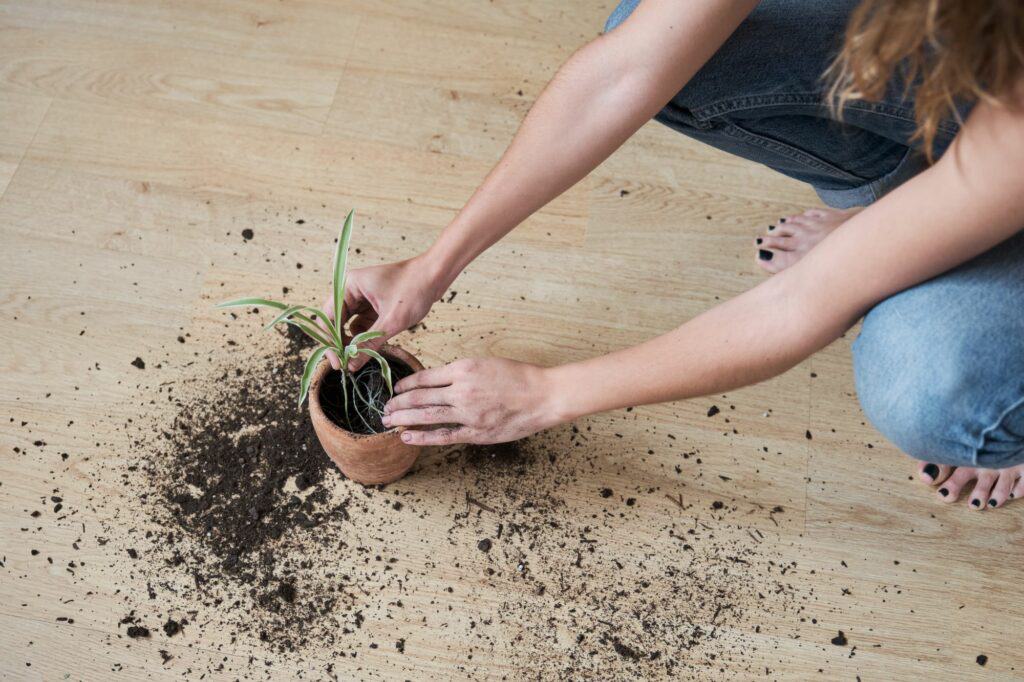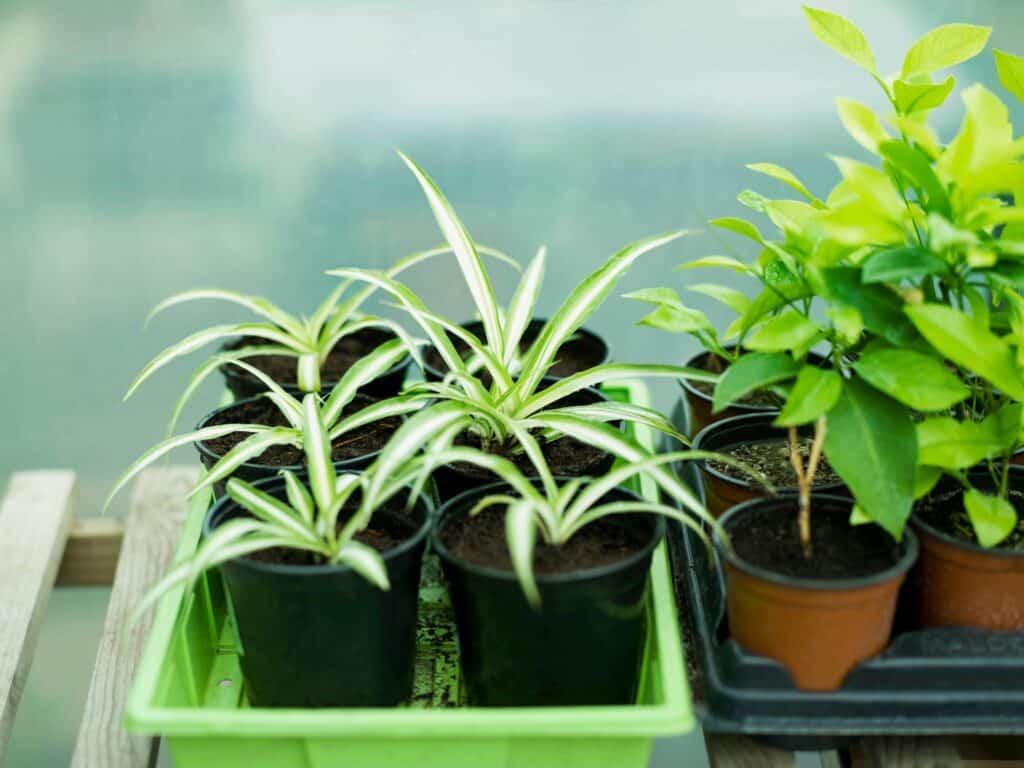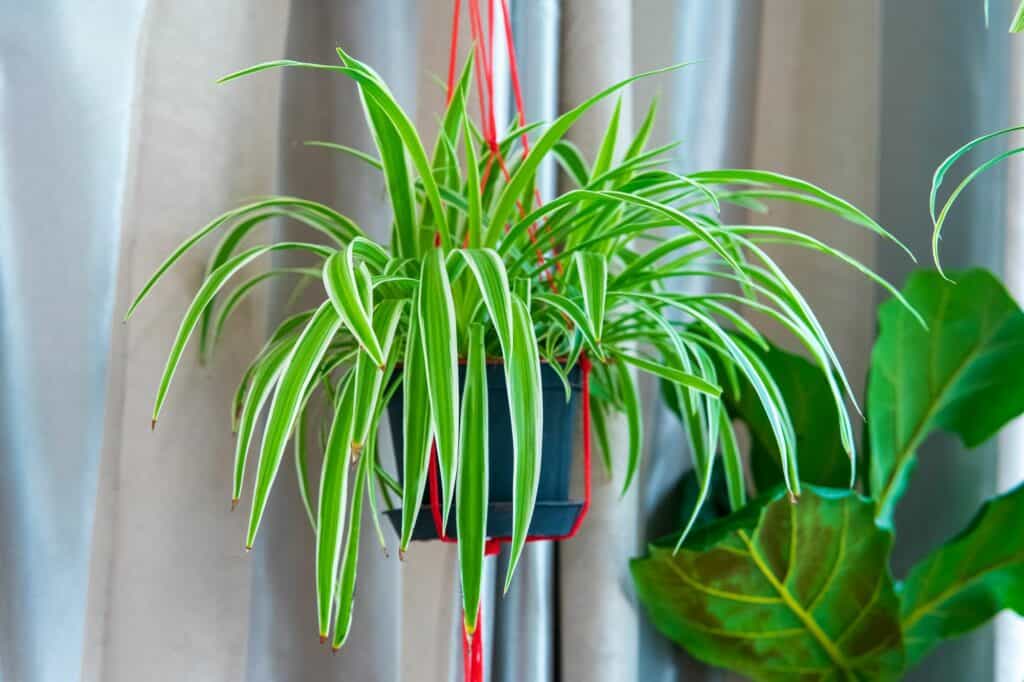Spider plants are a popular choice for indoor gardening, and one of the reasons is their ability to produce spider plant seeds.
These seeds can be used to propagate new plants, making spider plants an excellent option for those looking to expand their indoor garden. But what do spider plant seeds look like, and how can you tell when they are ready to be harvested?
Spider plant seed pods start off as small, green heart-shaped balls that can appear anywhere along the plant’s arching stems. As they mature, the pods turn brown and eventually open up to reveal the seeds inside.
The seeds themselves are very small and black in color, resembling poppy seeds. Knowing what spider plant seeds look like is essential if you want to collect and propagate them successfully.
Collecting spider plant seeds can be a fun and rewarding activity for indoor gardeners. By understanding the characteristics of the seeds and knowing how to care for them, you can grow healthy spider plant seedlings that will thrive in a variety of settings.
Whether you are a seasoned gardener or a beginner, spider plants are an excellent choice for anyone looking to add some greenery to their home.
Key Takeaways
- Spider plant seeds are small and black, resembling poppy seeds.
- Spider plant seed pods start off as green heart-shaped balls and turn brown as they mature.
- Collecting and propagating spider plant seeds can be a fun and rewarding activity for indoor gardeners.
Learn more about spider plants from other articles!
How to Revive a Dying Spider Plant: 4 Essential Tips
Can Spider Plants Live Outside in Winter? 5 Best Care Tips
Can I grow spider plant in aquarium? 5 Important Considerations

Understanding Spider Plant Seeds
Spider plants are one of the easiest plants to grow, and they are known for their ability to produce numerous spiderettes or baby plants. However, many gardeners are not aware that spider plants also produce seeds.
Spider plant seeds are small and black in color, and they look similar to poppy seeds. The seeds are typically found inside the seed pods, which are initially green and heart-shaped in appearance. As the pods mature, they turn brown and eventually open up to reveal the seeds inside.
To collect spider plant seeds, gardeners should wait until the seed pods are fully mature and have turned brown. Once the pods have opened, the seeds can be collected and stored in a cool, dry place until they are ready to be planted.
When planting spider plant seeds, gardeners should keep in mind that germination can take up to a few weeks. It is recommended to plant the seeds in a well-draining potting mix and to keep the soil moist until the seedlings emerge.
It is important to note that spider plants need to be pollinated in order to produce seeds. Gardeners can do this themselves by gently brushing a cotton swab against one flower after the other, or they can simply put the plant outside to allow insects to pollinate it naturally.
What Do Spider Plant Seeds Look Like
Spider plant seeds are very small and can be difficult to see with the naked eye. They are typically black in color and have a slightly oblong shape, similar to poppy seeds. The seeds can be collected from the small, star-shaped flowers that bloom on the spider plant.
Spider plant seeds are produced after the plant has been pollinated, either naturally or through manual pollination. The plant will produce small clusters of seeds that can be harvested and used to grow new spider plants.
When planted, spider plant seeds will germinate into seedlings that resemble miniature versions of the adult plant. The seedlings will typically have two small leaves when they first emerge and will grow larger over time.
It is important to note that spider plant seeds can take several weeks to germinate, so patience is key when growing these plants from seed.
In addition, spider plant seeds require warm temperatures and moist soil to germinate, so it is important to provide the right growing conditions for the seeds to be successful.

Spider Plant Seed Propagation
Spider plants are popular houseplants that are easy to propagate from seeds. Propagation is the process of creating new plants from existing ones. Seeds are a great way to propagate spider plants, as they are readily available and produce healthy plants.
Germination
Spider plant seeds are small and black in color, and they look a little like poppy seeds. Germination can take up to a few weeks. To germinate spider plant seeds, plant them in moist soil and keep them in a warm, humid location. Keep the soil moist by watering it regularly, but be careful not to overwater it.
Planting
Fill a container with potting soil and lightly press the seeds into the soil. Cover the container with a plastic bag or plastic wrap to keep the soil moist. Place the container in a warm, humid location, such as a greenhouse or a sunny windowsill. Keep the soil moist by watering it regularly.
Temperature and Light
Spider plant seeds germinate best in warm, humid conditions. Keep the container in a location that receives at least 8 hours of indirect light daily. Avoid direct sunlight, as it can dry out the soil and damage the seedlings.
Spring and Fall
Spider plant seeds can be planted in early spring or fall. Planting in early spring will give the seedlings plenty of time to grow before winter. Planting in the fall will give the seedlings a head start for the next growing season.
Humidity
Spider plants prefer high humidity, so it is important to keep the soil moist and the air humid. You can increase the humidity by misting the seedlings with water or placing a tray of water near the container.
Caring for Spider Plant Seeds
Spider plants are easy to grow from seeds. The seeds are small and black, and they are produced in seed pods after the plant has bloomed. Once the seed pods have turned brown and dried out, they can be harvested by gently pulling them off the plant.
To care for spider plant seeds, it is important to provide them with the right growing conditions. The optimal soil temperature for spider plant seed germination is around 70-75°F. Place the seeds in a well-draining soil mix and keep them moist by misting them with a spray bottle. Cover the tray with a plastic bag or dome lid to trap moisture and heat during germination.
Spider plant seeds require indirect light or light shade to germinate. Direct sunlight can be too harsh for the delicate seedlings. Once the seeds have germinated, they can be moved to a sunny location. Spider plants prefer bright, indirect light but can tolerate low light conditions.
It is important to keep the soil moist but not waterlogged. Overwatering can cause the seeds to rot. Water the seeds when the top layer of soil feels dry to the touch. Spider plants like humidity, so misting the soil and leaves with a spray bottle can help create a humid environment.
Fertilizing spider plant seeds is not necessary until they have established themselves. Once the seedlings have grown a few inches tall, they can be fertilized with a balanced fertilizer every two to four weeks. Use a well-balanced, water-soluble fertilizer diluted to half strength.
Spider plant seeds can be susceptible to pests such as spider mites and aphids. Inspect the seedlings regularly for signs of infestation, and treat them with an insecticidal soap if necessary.
Harvesting Spider Plant Seeds
Spider plants are popular houseplants that are easy to grow and care for. They are known for their long, thin leaves and spider-like plantlets that hang from the mother plant. While spider plants can be propagated by planting the plantlets, they can also be grown from seeds.
When spider plants mature, they produce seed pods that contain several small black seeds. These seed pods are usually located at the end of the long stems that hold the plantlets. To harvest spider plant seeds, wait until the seed pods have turned brown and dried out.
To harvest the seed pods, gently twist them off the stem and place them in a container. You can also cut the stem with the seed pod attached using a pair of scissors or pruning shears. Be careful not to damage the seed pod or the seeds inside.
Once you have harvested the seed pods, you need to remove the seeds from the pod. This can be done by gently breaking open the pod and removing the seeds. The seeds are small and black in color, and they look similar to poppy seeds.
It is important to note that spider plant seeds do not store well, so it is best to plant them as soon as possible after harvesting. If you are not ready to plant the seeds immediately, you can store them in a cool, dry place for a few weeks.
To plant spider plant seeds, soak them in water overnight to help speed up the germination process. Then, plant the seeds in a pot filled with well-draining soil. Keep the soil moist but not waterlogged, and place the pot in a warm, bright location.

Transplanting and Repotting Spider Plant Seedlings
When it comes to transplanting and repotting spider plant seedlings, there are a few things to keep in mind.
First, it’s important to wait until the plantlets have grown to a decent size before transplanting them. This will ensure that they have a better chance of surviving the transplant process.
When it’s time to transplant the spider plant seedlings, it’s important to choose the right container. A container that is slightly larger than the current one is ideal.
The container should also have good drainage to prevent water from accumulating and causing root rot.
Next, it’s important to choose the right soil for the spider plant seedlings. A well-draining potting mix is ideal. This will allow excess water to drain away from the roots, preventing the soil from becoming waterlogged.
To repot the spider plant seedlings, gently remove them from their current container, being careful not to damage the roots. Place them in the new container and fill in any gaps with fresh potting soil.
After transplanting, it’s important to water the spider plant seedlings thoroughly. This will help the soil settle and ensure that the roots have access to the moisture they need to grow.
Potential Issues with Spider Plant Seeds
Spider plant seeds are relatively easy to grow and propagate, but there are a few potential issues that growers should be aware of.
Pests
Spider plant seeds can be vulnerable to pests such as spider mites, mealybugs, and aphids. These pests can damage the seeds and hinder their growth.
To prevent pest infestations, growers should keep their growing area clean and free of debris, and regularly inspect their plants for signs of infestation.
If pests are detected, growers can use insecticidal soap or neem oil to control the infestation.
Drought-Tolerant
Spider plants are known for their drought-tolerant nature, but this does not mean that they should be completely neglected.
Overly dry soil can cause spider plant seeds to dry out and fail to germinate. Growers should water their spider plant seeds regularly, but avoid overwatering as this can lead to root rot.
Overwatering
Overwatering can also cause spider plant seeds to fail to germinate. The seeds should be kept moist, but not overly wet. Growers should allow the soil to dry out slightly between watering to prevent overwatering.
Root-Bound
Spider plant seeds can become root-bound if they are left in the same container for too long. This can cause the roots to become tangled and stunted, and can hinder the growth of the plant.
Growers should transplant their spider plant seeds into larger containers as they grow to prevent them from becoming root-bound.

The Spider Plant in Different Settings
Spider plants are versatile and can be grown in various settings. They can be grown indoors as houseplants, outdoors in the garden, or in hanging baskets. They are a popular choice for novice gardeners because they are easy to care for and propagate.
Houseplants
Spider plants are popular as houseplants because they can tolerate low light conditions and are easy to care for. They can be grown in pots or hanging baskets, and they make great additions to any room.
They are also known for their air-purifying properties, making them an excellent choice for improving indoor air quality.
Gardens
Spider plants can also be grown in the garden. They are hardy plants that can grow in a variety of soil types and hardiness zones.
They are often used as edging plants or as ground cover in landscape designs. They can also be used to add texture and interest to flower beds.
Hanging Baskets
Spider plants are a popular choice for hanging baskets. They are easy to care for and can tolerate a range of growing conditions.
They are also known for their cascading foliage, which makes them an attractive addition to any hanging basket display.
Spider Plant Varieties
Spider plants are a popular houseplant that are easy to care for and propagate. There are several varieties of spider plants, each with their own unique characteristics.
Variegated Spider Plants
The most common variety of spider plant is the variegated spider plant. This variety has green and white striped leaves that grow up to 16 inches long. Variegated spider plants are easy to care for and can thrive in a variety of lighting conditions.
Bonnie Spider Plants
Bonnie spider plants are a popular variety that have curly leaves. These plants can grow up to 18 inches tall and have a compact, bushy growth habit. Bonnie spider plants are also known for their ability to remove toxins from the air.
Spiderwort
Spiderwort, also known as Tradescantia, is a type of spider plant that has green leaves with purple undersides. This variety can grow up to 12 inches tall and has small white flowers that bloom in the summer.
Chlorophytum Comosum
Chlorophytum comosum is the scientific name for the spider plant. This variety has long, narrow leaves that can grow up to 20 inches long. Chlorophytum comosum is a hardy plant that can tolerate a wide range of growing conditions.
Frequently Asked Questions
How do you get seeds from a spider plant?
To get seeds from a spider plant, wait for the plant to produce flowers. Once the flowers have bloomed, pollination is necessary to produce seeds. This can be done by gently brushing a cotton swab against one flower after the other, or by allowing insects to pollinate the plant naturally. After pollination, seed pods will start to form on the plant. Wait for the seed pods to mature and turn brown before harvesting them.
Where are the seeds on a spider plant?
Seed pods can form anywhere along the arching stems of a spider plant. The pods are small, green, and heart-shaped when they first appear. As they mature, they turn brown and eventually open up to reveal the seeds inside.
What do the seeds of a spider plant look like?
Spider plant seeds are very small and black in color. They are often described as looking like small, round beads.
Does a spider plant have seeds?
Yes, spider plants do have seeds. The seeds are produced after the plant has been pollinated and the seed pods have matured.
Are spider plant seeds poisonous?
Spider plant seeds are not poisonous and are safe to handle. However, it is important to note that the plant itself can be toxic to pets such as cats and dogs.
Can you buy spider plant seeds?
Yes, spider plant seeds can be purchased from various online retailers and garden centers. However, it is important to note that spider plants are very easy to propagate from their plantlets, so buying seeds may not be necessary.

Hey, I’m Lisa and I’ve been an avid gardener for over 30 years. I love writing, talking and living in the garden! Feel free to connect with me on my socials below


